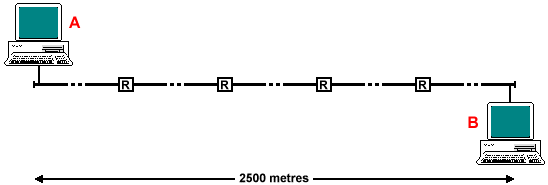| Author: | |
| Website: | |
| Page title: | |
| URL: | |
| Published: | |
| Last revised: | |
| Accessed: |
Ethernet is the networking technology used by most modern LANs, and was developed in the early 1970s at Xerox PARC by Doctor Robert Metcalfe. Metcalfe persuaded Xerox to allow Ethernet to become an open technology, which led to it becoming the most widely adopted networking technology. The transmission medium originally used for the network backbone was 10Base5 coaxial cable, with the network arranged in a bus topology. 10Base5 was later replaced by the cheaper 10Base2 coaxial cable as the backbone medium. Modern Ethernet networks typically use a star topology. Ethernet uses carrier sense multiple access with collision detection (CSMA/CD) as the method of medium access, and has been standardised by the IEEE as IEEE 802.3. Standard Ethernet has a data rate of 10 Mbps and allows frame sizes of between 64 and 1518 bytes. The frame format can be seen below.

IEE 802.3 CSMA/CD frame format
The table below describes the Ethernet frame fields.
| Field | Description |
|---|---|
| Preamble | Alternating 1s and 0s (used for synchronisation) |
| SD | Start Delimiter - signals start of valid frame |
| DA | Destination Address (48 bits) |
| SA | Source Address (48 bits) |
| Lng | Length - indicates number of bytes in data |
| Data | Minimum 46 bytes to maximum 1,500 bytes |
| Pad |
Bytes added to achieve minimum frame length - needed for reliable collision detection |
| FCS | Frame Check Sequence - algorithm for error detection |
The term multiple access refers to the fact that stations on the network share a common transmission medium. Carrier sense refers to the manner in which stations monitor the transmission medium, and attempt to transmit only when they sense that the medium is free. Collision detection is achieved by monitoring an outgoing transmission in order to detect any other signals on the line which may interfere (or collide ) with the signal being transmitted. If a collision is detected, all of the stations involved will back off for a random period of time (the deferral time ) before attempting to retransmit. CSMA/CD is described as a contentious method of medium access, because stations are essentially competing with each other for use of the transmission medium. This works well for networks carrying only light traffic, but a significant increase in traffic will result in a higher number of collisions. This will create additional network overhead in terms of dealing with the collisions, and even more network traffic due to the need for re-transmission of lost frames. The net result will be a degredation of the overall performance of the network.
If the network is quiet, a station will transmit the preamble (alternate 1s and 0s) so that active stations can synchronise on this signal. The last two bits of the start delimiter are both binary 1, signalling that the frame proper is about to start. The next thing to be transmitted is the destination address (DA), which all stations compare with their own destination address. The station with the matching address reads the frame data, while all other stations simply ignore the frame. After transmitting the start delimiter, the sending station begins monitoring its outgoing transmission to enable it to detect a collision condition. If no collision has occurred during transmission of the first 64 bytes, the station has "acquired" the channel (i.e. no collisions will occur thereafter). After successful transmission, all stations wait for a specified time before attempting to transmit, to allow the system to settle before another frame is transmitted.
Ethernet networks normally operate at 10 Mbps (Standard Ethernet ), 100 Mbps (Fast Ethernet) or 1,000 Mbps (Gigabit Ethernet). Gigabit Ethernet is currently used primarily as a high-speed backbone for existing LANs, while unshielded twisted pair cable (Cat5E or Cat6) is used to connect end-user equipment (i.e. workstations, printers etc.) to network switches in a star configuration.
The following rules apply to Standard Ethernet (10 Mbps):
| Minimum frame size (excluding preamble): | 64 bytes |
| Maximum transceiver-transceiver distance: | 2,500 M |
| Maximum number of segments: | 5 |
| Maximum number of repeaters: | 4 |
| Maximum number of populated segments: | 3 |
The rules are designed both to optimise the performance of the Ethernet network and to ensure that collisions that do occur on the network do not go undetected. Consider a worst-case scenario in which five segments are used, each 500 metres in length, connected together using four repeaters, as shown below.

Ethernet segments connected by repeaters
In order to detect a collision, the transmitting station must monitor its own transmitted signal. It can only, therefore, detect a collision if the collision signal reaches it before it stops transmitting. Consider the worst-case scenario in which station A transmits a 64-byte frame which propagates along the network almost (but not quite) as far as station B. If B has some data to transmit, it will do so, not yet having detected A's transmission. The two signals will collide almost immediately at B's end of the network, but the collision signal must travel all the way back to A in order for A to detect it. How long does this take? Given that signals propagate at (circa) 2x108 metres per second, and that there is a delay in each repeater of approximately 1.5 µs in both directions, the round trip delay will be:
(2 x 4 x 1.5 ms) + (2 x ((25 x 102)/(2 x 108))) = 37 µs
The time taken to transmit the frame will be:
(64 x 8)/(10 x 106) = 51.2 µs
So, even in a worst-case scenario, a collision will be detected.